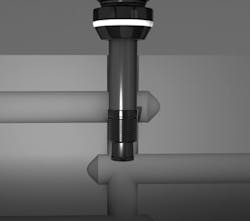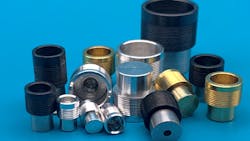Robotics Ease Installation of Expansion Sealing Plugs
EIS - Engineered Inserts & Systems Inc. has begun using robotics for the installation of its sealing expansion plugs, particularly the EIS Pull Plug. Doing so helps to ensure fast and accurate installation of the plugs, benefiting end-use customers.
With the improved speed and accuracy robots provide, productivity can be increased, which has been a driving factor for their growing use in recent years.
How EIS is Employing Robotics
To aid installation of its expansion sealing plugs, EIS moved toward use of robotics. Tooling mounted to a robotic arm is controlled using cameras or a jog and teach program. This enables the robot to locate the plug and self-thread it onto a mandrel. Then it is ready for installation into a hydraulic manifold.
The robotic arm moves to the corresponding hole into which the plug is to be installed and places it in the hole at the required depth. According to the company, this can be done in a fast, secure and repeatable manner without any errors.
Data collection capabilities are built into the robot, enabling users to verify all holes have been plugged as required and are 100% sealed. This information is recorded as well to provide an accurate record for any future needs.
Automating the installation process for its sealing plugs through the use of robotics helps to speed up the process by eliminating human error and rework as well as increasing efficiency and ensuring proper sealing is achieved.
What is the EIS Pull Plug?
EIS introduced its Pull Plug in 2013 to offer the industry an easier to install sealing plug; use of robotics to install the plug further increases their ease of use.
The EIS Pull Plug design eliminates the scraped mandrel common with rivet style plugs which the company says helps to reduce its cost. Instead, it used the spin pull technology of the installation tooling to automatically thread the Pull Plug onto the tools mandrel where it sits ready to be installed.
EIS further describes the installation process for the Pull Plug:
Placing the expander into the simplified straight bore while the nose of the tool keeps the plug body slightly below flush to the surface of the material, the operator simply depresses the trigger actuating the tool to pull the pin into the plug body at a predetermined stroke, consistently (not relying on a desired break force to be reached, to separate such as the rivet style plug), causing the full radial expansion then reversing its spin to remove itself from the successfully installed plug.
According to the company, this eliminates waste while providing fast and secure installation.
Additional benefits of the EIS Pull Plug include:
- Mandrel built onto tool to install plug at any depth
- Internal thread pulls pin to body enabling various uses
- Sizes from 4-22 mm
- Low-, high- and ultra high-pressure versions available
- Can be manufactured in variety of materials including steel, aluminum, titanium and stainless steel
Read more from EIS about sealing plugs.
About the Author
Sara Jensen
Executive Editor, Power & Motion
Sara Jensen is executive editor of Power & Motion, directing expanded coverage into the modern fluid power space, as well as mechatronic and smart technologies. She has over 15 years of publishing experience. Prior to Power & Motion she spent 11 years with a trade publication for engineers of heavy-duty equipment, the last 3 of which were as the editor and brand lead. Over the course of her time in the B2B industry, Sara has gained an extensive knowledge of various heavy-duty equipment industries — including construction, agriculture, mining and on-road trucks —along with the systems and market trends which impact them such as fluid power and electronic motion control technologies.
You can follow Sara and Power & Motion via the following social media handles:
X (formerly Twitter): @TechnlgyEditor and @PowerMotionTech
LinkedIn: @SaraJensen and @Power&Motion
Facebook: @PowerMotionTech

Leaders relevant to this article:



